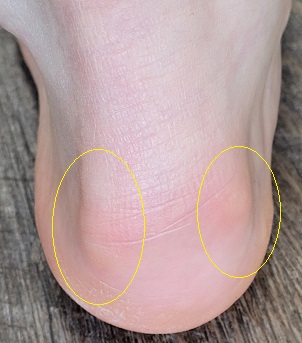
Extra bump on the foot
An extra bump can be present on the foot for various reasons. Some can be the way the foot structure is from genetics, and some can develop over time. The more common bumps that are visible on the foot are on the inside of the arch, top of the foot, side of the toe and the back of the heel.
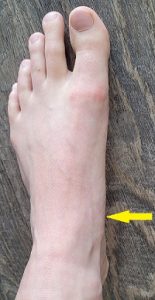 Extra bump on the inside of the arch
Extra bump on the inside of the arch
An extra bump on the inside of the arch can develop from a genetic condition or from a flat foot. This bump forms on the navicular bone, which is on the inside of the foot, just below and in front of the ankle bone.
An accessory navicular is when an extra bone is present on the navicular. It is considered a development anomaly which may or may not cause pain. Because this creates a more prominent bump on the foot, it is more likely to rub on shoes or inserts.
Even without the extra bone from an accessory navicular, a flat foot can cause this navicular bone to shift out and look more prominent. When this happens, the bone can rub against the shoe when the foot collapses into it. With a foot that collapses completely flat, the bone will rub against the ground and bottom of the shoe.
Treatments
When this bone is present, it is typically an indication that some sort of treatment should be considered to prevent or reduce pain.
Support
Support from a custom foot orthotic or over the counter insert can reduce stress to the bump. A muscle, called the tibialis posterior, helps to prevent an arch collapse and attaches to this navicular bone. If the foot is collapsing in, this muscle pulls harder on the bone and creates additional stress. The support will keep the arch from collapsing excessively and reduce the stress on the navicular bone.
Shoes
Wearing the right shoes can also help to reduce stress at the navicular bone.
Make sure there are no hard pieces or seams where the bone lines up on the shoe. If there is a hard piece or a seam, the pressure on the bone will increase while standing or walking.
Even with support inside the shoe, it’s still important to wear a shoe with the appropriate support. A wide base and a solid foundation will prevent excessive motion to the foot. Wearing a great orthotic in a flimsy shoe can still allow your foot to move and rub against the shoe.
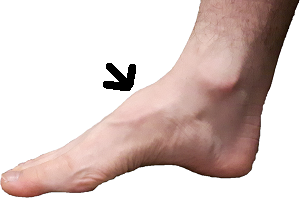 Extra bump on the top of the foot
Extra bump on the top of the foot
A bump on the top of the foot can develop from a high arch or a low arch. This bump typically forms in the area between the ankle and the toes and is called a dorsal exostosis.
A high arch can lead to this dorsal exostosis because of the structure of the foot and the way it rubs on a shoe. A high arch puts the bones at an angle that can make the bones at top of the foot more prominent. This can rub on shoes and eventually lead to irritation and a bone growth on the top of the foot.
A low or collapsed arch can also lead to this dorsal exostosis. In a low arch, the bones are more flexible when walking and they can rub excessively leading to a bone growth. If the foot is moving excessively inside the shoe, the top of the foot can also rub against the shoe. Improper shoe fit can exaggerate the motion inside the shoe, creating additional rubbing to the top of the foot.
Treatments
If there is pain at the bump, or you would like to prevent the bump from worsening, there are a few steps that can be taken.
Shoes
Wearing the right shoes can make a big impact in reducing pressure or rubbing at the bump.
First, make sure the shoes fit properly. They should have the appropriate length, width and depth to prevent excessive motion or pressure. Lace-up shoes are ideal to adjust for any excess pressure points on the top of the foot. Velcro can also be helpful, but the more straps there are, the more adjustability options there are.
Changing the lacing on shoes can reduce any pressure or rubbing on the bump. Do this by skipping an eyelet where the bump is. This will create an opening in the laces so they don’t cross over the bump.
Support
In some cases, additional support may be necessary to reduce excessive motion. If the foot is rolling in or out, custom foot orthotics or over the counter inserts can help reduce the motion in the shoe.
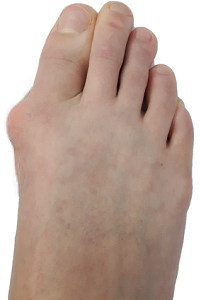 Extra bump on the side of the toe
Extra bump on the side of the toe
A bump on the side of the toe is commonly a bunion or a bunionette. A bunion forms on the inside of the big toe and a bunionette forms on the outside of the little toe. Both of these can be caused from improper shoe fit, the way you are walking and genetics.
If the shoe is too tight, it can compress the feet and lead to excessive pressure to the sides of the foot. Frequent high heel wearers are more susceptible to this because the way heels are made increases the pressure on the sides of the feet.
If you roll in or out excessively, it can lead to excessive pressure at the sides of the foot. Rolling in (pronation) puts more pressure on the inside of the foot when pushing off the back leg. It can also cause pressure to the outside of the foot because when the foot rolls in, the outside of the foot can push against the side of the shoe. Rolling out excessively puts pressure on the outside of the foot when pushing off the back leg.
Treatments
To deal with pain or prevent a bunion or bunionette from getting worse, the proper shoes and support can make a big difference.
Shoes
Wearing shoes that give the toes enough room will help reduce pressure to the sides of the feet. Find a shoe that is wide enough for the feet, and one that doesn’t point at the toes.
Support
Wearing the appropriate support, through a custom foot orthotic or over the counter insert, can align the foot to prevent the back foot from pushing off too far inside or outside. This can reduce stress to these areas and prevent the bumps from worsening as quickly.
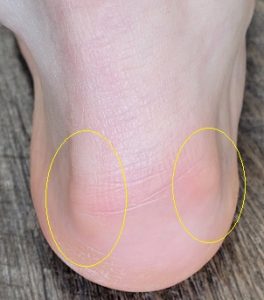 Extra bump on the back of the heel
Extra bump on the back of the heel
A Haglund’s deformity is the term for a bump forming on the back of the heel. This bump typically forms from excessive motion at the heel. This excessive motion could be poor shoe fit or excessive collapse of the foot.
If a shoe does not fit right, the heel can slide up and down excessively. It is normal to have slight motion at the heel when walking in a shoe, but it can lead to abnormal pressure if the motion is excessive.
When the foot collapses excessively, the heel can move and rub against the back of the shoe. When the heel also collapses excessively, this increases the rubbing at the heel significantly.
Treatments
If there is pain at the bump, or you would like to prevent the bump from worsening, there are a few steps that can be taken.
Support
Support through custom foot orthotics and over the counter inserts can reduce motion caused by excessive collapse. Arch support would help to prevent collapse at the arch, but additional support may be needed at the heel. When additional support is needed to prevent collapse specifically at the heel, custom orthotics or modified over the counter inserts would be best.
Shoes
If your heel is slipping inside your shoe, there are a few techniques that can help.
Changing up your laces can help to keep your heel from sliding up and down excessively. First, try using the very last eyelet on a shoe. This extra eyelet is typically found in a running shoe. Remove the lace from the second last eyelet, and relace it into the last one. This provides a more secure fit at the heel.
If the heel is still sliding using the last eyelet, the heel lock technique will provide a more secure fit. In this technique, feed the lace through the second last eyelet, and back down through the last eyelet on the same side. Repeat on the opposite side of the shoe. Then, cross the laces over to the opposite side and fed them through the loop you created. To see this technique step by step, it can be found on our YouTube video: https://www.youtube.com/watch?v=GfFtaCOdMUc
If there is a lot of room for your foot at the front of the shoe, an extra insert can be added. Take a flat insert from a shoe you are not using (or bought from a store), cut it in half through the arch, and add the front part of the insert in the shoe. Place this insert under the original insert to prevent bunching and sliding.
A piece of material called a tongue pad is another helpful tool. It is a piece of fabric that will stick to the inside of the shoe tongue. It helps to keep your foot from sliding forward.
All these techniques can be found on our YouTube video as well: https://www.youtube.com/watch?v=ASXm0MsWVdE.
Conclusion
An extra bump on the foot can be harmless, but should be addressed if there is pain involved. Dealing with a high arch, low arch or excessive motion in the shoe can address most problems with extra bumps.
If you have any questions or would like your feet looked at, feel free to contact us or book an appointment!

You must be logged in to post a comment.